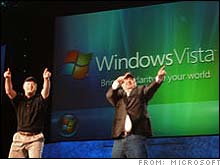|
Microsoft's labor troubles
On top of a stagnant stock and a host of new competition, the software giant is said to be struggling to attract the best young talent.
NEW YORK (CNNMoney.com) - Microsoft's all grown up. Now, along with the middle-age woes of a stagnant stock and a host of new competition, the world's biggest computer software maker apparently can add "attracting young blood" to its list.
Microsoft (Research) employees are growing more and more disillusioned with stagnating salaries and an increasingly contentious review system that they say is unfair, according to a recent report in WashTech News. That's led to more defections by senior engineers and growing dissatisfaction among rank-and-file workers, the report said. The publication is affiliated with the Washington Alliance of Technology Workers, a labor union affiliated with the AFL-CIO that has tried to organize Microsoft workers in the past. At issue is the company's performance review system, according to the report. Microsoft employs some 38,000 workers in the U.S. alone. Some workers have complained that the review process has become tainted, rewarding workers based on office politics rather than performance. But the problems at Microsoft underscore a larger labor issue facing companies once famous for spawning millionaires via lucrative stock options. These companies now have to find ways to keep top talent from defecting to younger competitors, such as Google (Research). It's also become a morale issue, experts say, since it has led to a kind of internal caste system at some companies, like Microsoft, where employees who joined before a certain point -- when the value of their stock options allowed them to become wealthy overnight -- are referred to as "in the money." (See correction.) "For young companies getting up and going, there's so much work to be done that politics takes a back seat to the job at hand," said Roger Kay, founder of Endpoint Technologies Associates, an independent research firm. Kay noted that at startups, even rank-and-file workers typically get stock or options or a combination of the two, so they can make serious money if a company takes off. That opportunity dries up when a company matures and its stock price stops rising, which he said was true of Microsoft. "They have a huge cash flow that finances a whole city of people, and yet where you can grow from there is actually fairly limited," Kay said. "Microsoft's stock price isn't going anywhere, and in that environment, politics that were background noise rise to the foreground." Staying cool -- at 31
Microsoft officials were not immediately available to comment. But spokesman Lou Gellos was quoted in WashTech News as saying Microsoft is aware that some employees are frustrated and that the company is seeking worker feedback on the review process. Michael Cherry, a 10-year Microsoft veteran who works at Directions on Microsoft, an independent research firm that follows the software giant exclusively, said that as companies such as Microsoft mature, they also have to maintain an image that the company is still a cool place to work -- a tough job when a company's flagship franchises are no longer viewed as cutting edge and competitors like Google and Yahoo! are seen as the innovators. "I've seen articles written about Google (that portrayed) this fun atmosphere where people are playing in the halls," Cherry said. "If you went back 15 years, you'd probably find the same articles written about Microsoft. Whether this is true or not, the perception is there are other places that are doing the exciting things." Cherry added that while employees coming out of MBA programs still rank Microsoft high for places they'd like to work, that may not be as true for tech employees like developers. "The best thing you can have as a manager of people working in high tech is that your people get up in the morning excited to come to work," Cherry said. A maturing company's struggle "is that some of those levers go away, like stock options, and you have to create new ones." The dreaded bell curve
If the WashTech News story -- and some employee blogs -- are any guide, Microsoft will also have to address its review system. Employees claim the process has degenerated into a popularity contest with managers trying to protect their friends, according to the WashTech report. While some employees earn a 4.0 score on a 1 to 5 curve and others get 4.5, employees dread getting a 3.0, which means an employee simply "meets expectations." Since Microsoft's culture is about exceeding expectations, that ranking "is a red flag that you're on your way out the door," one employee anonymously told WashTech News. In a blog posting entitled, "Microsoft's 3.0, (or, How I Learned To Stop Worrying and Love The Curve)," an anonymous Microsoft employee argued that the system can put pressure on managers to grade employees unfairly. The blogger, writing at "http://minimsft.blogspot.com," maintains that Microsoft has become too bloated and calls for it to get "lean and mean" to better compete, and also argued the review system is fundamentally flawed in that it can unfairly punish talented workers. "Woe unto you if you're a super-star in a super-super-star peer group," the blogger wrote. Despite these issues, Microsoft landed at number 42 on Fortune magazine's annual "100 Best Companies to Work For" list. That's up from number 57 last year but down from its 2004 ranking of 25. --------------------------- An earlier version of this story erroneously stated that in 1997, Microsoft stopped issuing stock options. CNN/Money regrets the error. Tough jobs make for great workplaces: More here.
Seeking India's Google and Yahoo!: Click here. |
|


